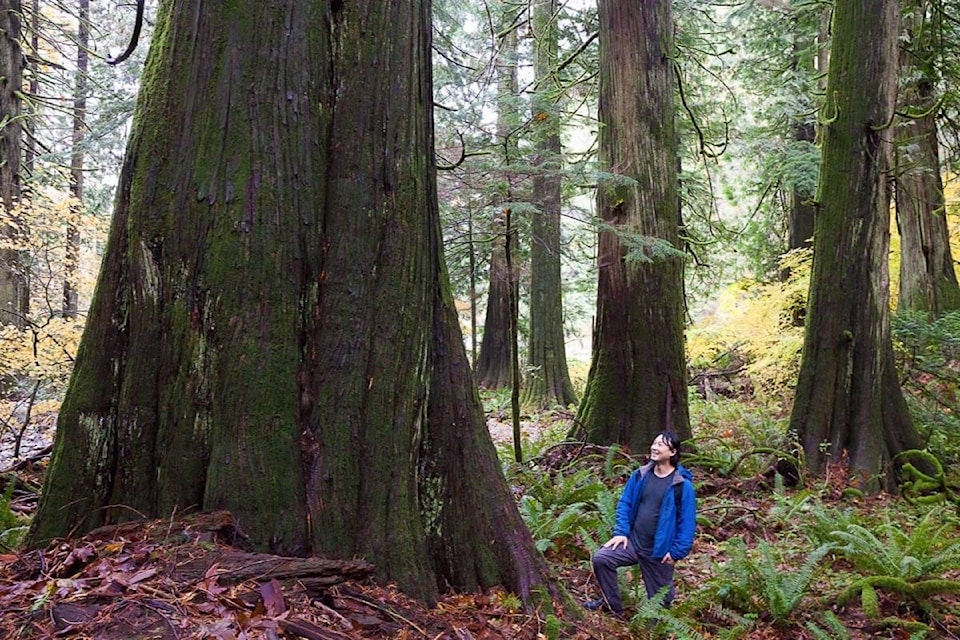The B.C. Ancient Forest Alliance (AFA) says the B.C. NDP’s new budget, released last week, neglects to address the need for old-growth-forest conservation.
In 2013, the then-Liberal provincial government protected roughly half of the old-growth forest around Echo Lake, an area rich with extremely rare, lowland old-growth forest located northwest of Harrison Mills.
The trees, mainly cedars and pines, are at least 140 years old – the minimum age of trees of those species for classification as old growth – and are the only ones known to the region.
While 55 hectares south of the lake were included in a protective Old-Growth Management Area (OGMA), at least 40 hectares on the north and west side of the lake remain unprotected and available for logging.
“The fate of B.C.’s old-growth forests has been one of the most pervasive and endearing large-scale public concerns in British Columbia’s history, since the early 1980s,” said AFA executive director Ken Wu.
“These are some of the oldest and largest living creatures that have ever existed in Earth’s history. These [forests] are important for endangered species… They’re important for the climate, they store huge amounts of carbon. They provide clean water [and] they’re important for First Nations culture as well, which evolved with the big cedars for making canoes and longhouses and totems.”
READ: Echo Lake home to diverse and endangered species
The old-growth forest around Echo Lake exists in the traditional, unceded territory of the Sts’ailes First Nation and is the largest night-roosting site for bald eagles on earth – with as many as 10,000 calling its trees home during fall salmon runs.
While no logging has occurred in the Echo Lake area yet, Wu said the north side of the lake remains unprotected and a kilometre-long logging road stands as a potential precursor to logging cutblocks in the area.
He hoped the new NDP government would consider protecting this part of the forest as OGMA and offer second-growth forests to logging companies in its place.
The AFA has been pushing the government to allocate money for land acquisition funds, so it can purchase old-growth forests on private land, but Echo Lake is already on Crown land, according to Wu, so purchase isn’t needed to protect it.
“It would require the government’s will to legislate protection and engage the First Nations owners in the area to assist them with land-use planning, finance [and] economic alternatives to logging old-growth forests,” he said.
The B.C. NDP’s 2017 platform made mention of plans to work with First Nations and communities to modernize land-use planning and management of the environment, including old-growth forests.
So it makes sense the AFA was hoping the NDP budget – the first released in 16 years – or the recent throne speech, would involve old-growth forest conservation.
“It just shows us that, even under an NDP government which many people have considered to be more predisposed to environmental issues, we still have to continually expand public awareness and mobilization so they do the right thing,” said Wu.
“We’re hoping the NDP can actually show some flexibility and environmental concern.”
In an emailed statement, spokesperson for the Ministry of Forests, Lands, Natural Resource Operations and Rural Development Vivian Thomas said, in regards to old-growth forests and protection in the Chilliwack natural resource district, that “over 500,000 hectares have been set aside to manage for wildlife, biodiversity and other values, including 1,000 hectares designated last year as the Lhá:lt Harrison-Chehalis Wildlife Management Area. By comparison, only 250,405 hectares is available for timber harvesting.”
The wildlife management area mentioned by Thomas does protect approximately 1,033 hectares of land near Harrison Mills and some of the region’s critical fish and wildlife species, but it falls short in protecting the ancient red cedars and lodgepole pines that grow just outside its boundaries.
The ministry made no comments in relation to future plans for protecting old growth.
For his part, Wu said he will continue pushing the government for more.
“We’re going to continue to organize hiking trips, we’re going to keep documenting these forests and we’ll continue to engage the province and the new government here so that they actually get up and do something instead of the status quo – which ultimately would result in fragmentation of the Echo Lake area,” he said.

